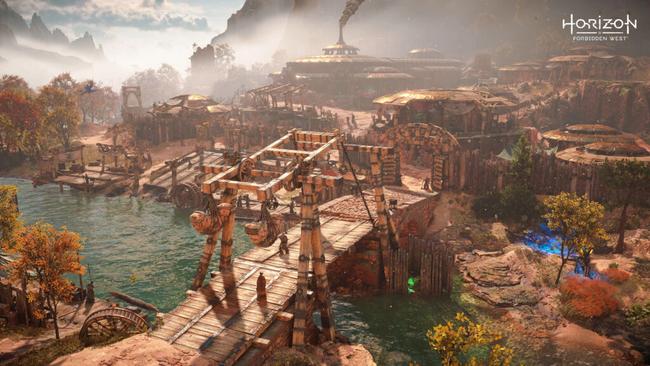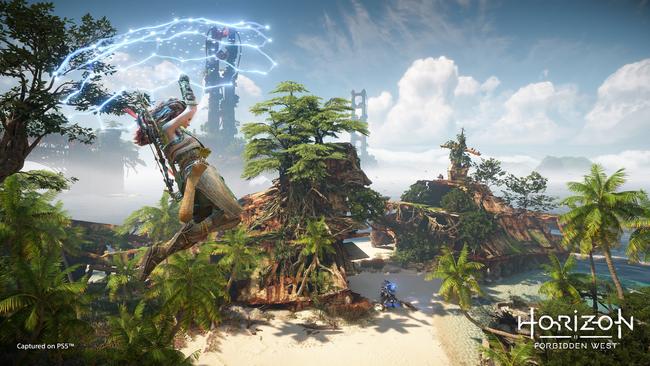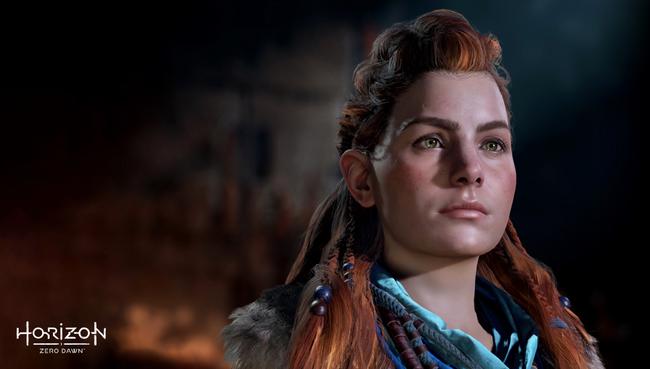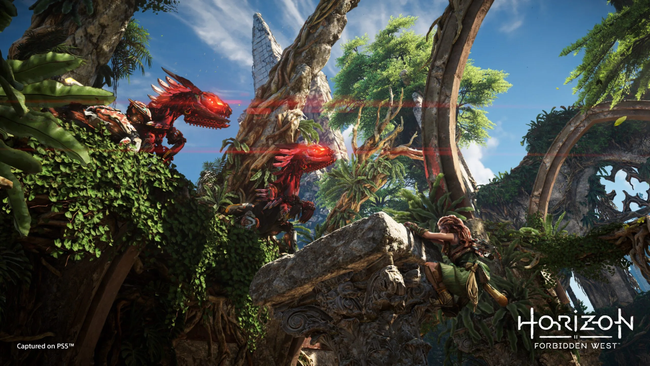
Horizon Forbidden West's developers dive deep into the upcoming RPG's rich worldbuilding
Horizon Forbidden West is right around the corner, adding its dinosaur-sized imprint on a very busy February 2022. Horizon fans have treasured May's 14-minute gameplay glimpse for quite some time now, and we've even known what to expect from Special Edition launch packages since September.
But for those of us who have been thirsting for an extensive understanding of the ways in which Aloy's world has changed since last we saw her, today's our lucky day. In a new PlayStation Blog post, Guerrilla Games' Community Lead, Bo de Vries, has blown the lid off the team's intuitive approach to building a vast and believable world.
The post opens with some broad statements on the game:
The Forbidden West is vast and deadly, filled with ancient ruins, awe-inspiring machines, and hidden threats. Surrounded by danger, its human inhabitants need places to train, rest, and improve their gear. The game’s settlements form these sanctuaries, and they are just as vital to Aloy as they are to the tribes that live in them.
The living world in these settlements is a complex character of its own. Every detail establishes credibility, creating an authentic environment through visual storytelling. For example, the Nora live in relative solitude in the isolated valley of the Sacred Land, making it difficult for them to communicate with the outside world. As a result, they are less technologically advanced than other tribes, and more wary of outsiders. Their settlements are made of wood and rope, featuring minimal furnishings other than what is needed for daily life. Food and resources are obtained through hunting and gathering, so there’ll be pelts, baskets, or sheaths full of arrows lying around. All the objects and people within such a settlement feel like they belong, and more so: like they’ve always been there.

There's a whole team in charge of the "Living World." Which is pretty neat.
World Building with Intention
With hours and hours of exploration in the Forbidden West, how do you create a lush and thriving world filled with activities, but without overwhelming people, or detracting from the overarching story? Espen Sogn, Lead Living World Designer at Guerrilla, explains how his team is central to this very question.
“When you walk through the Forbidden West, everything should feel like it belongs there. The Living World team at Guerrilla works on aspects of the game that make the world feel authentic and alive: the tribes, the settlements, and the people within them. There’s an intention behind everything we place within the world.”
Clarity on those intentions comes from collaboration with the narrative team. “At the start of a project, we put a lot of thought into every tribe we’re going to encounter,” says Annie Kitain, senior writer at Guerrilla. “What their conflicts are, how they fit into the story, and how they interact with the world around them. Take the Tenakth, for instance. Many of their beliefs are influenced by the ancient ruins of the Forbidden West, and unlike other tribes, they’re comprised of three distinct clans. Their shared history, convictions, disputes—all of that is important to developing the characters that Aloy will meet on her journey.”
“Our main challenge is translating this narrative framework into visuals that are integral to the world itself,” says Espen. “For example, the Tenakth are known to be competitive and combat-focused, but so are other tribes. So how do we distinguish them, and how do we communicate that visually?
“It then becomes all about the details, the animations, and the behaviors. Within their settlements, you’ll see the Tenakth working out, readying themselves for battle. They’re often younger because they need to be capable warriors. Their base is an ancient ruin, from which they’ve picked up certain Old World gestures that they may not fully understand—like using a military salute to say hello.
“Ultimately, our goal is to make sure NPCs feel connected to where they live, and we work closely with other internal teams, such as Narrative, Quest, and Environment, to make sure that every location feels authentic.”
“The Living World team does a fantastic job, and it’s so great to see it all come together,” says Annie. “Each tribe starts as a bunch of ideas, then is translated into these amazing settlements. Like the Utaru, who were imagined as an agrarian society that’s deeply connected to the land around them. Once the tribe is in-game and the Living World team has done their magic, you’re walking around the Utaru’s fields, interacting with them, and you think, ‘whoa, they nailed it.’ Now this tribe feels real.”

Non-verbal differentiation between tribes has been a hallmark of what the Living World team has strived to achieve.
Authenticity Through Behavior
With a world as vast as the Forbidden West, it was important for the team to maintain the level of authenticity that was achieved in Horizon Zero Dawn. “Every non-combat NPC in Horizon Forbidden West is part of a crowd system,” says Espen. “Within that system, you can create rules such as reactions, walking paths, and other animations. We then also have the attitude system, which determines a personality. This means we can create unique people who behave like individuals within the world.
“We are constantly adding layers of authenticity within the world through animations and behaviors. When members of a tribe are in their settlement, their safe spaces, they can act like themselves. The Oseram are a social and historically patriarchal tribe, so their animations are more about shoulder punches and high fives. The Utaru, on the other hand, are laid back, so they will often sit down together and be a bit more touchy-feely. As the player moves around, these are potential subconscious hints that will help you visualize where in the world you are.
“All of this happens within the game’s narrative framework. You should be able to identify from a distance which tribe you’re looking at. The way that different tribes hold or transport water: the strong Tenakth will carry it on their shoulders; the peaceful Utaru will hug it closely; and the crafty Oseram will carry it with their hands.”

Particular attention is placed upon an Oseram settlement called Chainscrape. Which is a rather... painful-sounding name for a town. But then, this is a tough world to live in.
Heading to Chainscrape
One of the first places Aloy will visit as she travels west is Chainscrape, an Oseram outpost settlement on the border. It offers abundant natural resources and opportunities for adventure and risk. Its tenants have come here for many reasons: to flee problems back home in the Claim, to make a few quick shards, to embrace a dream, or for the thrill of exploration. It’s a busy hub, featuring a town bar where Aloy can meet some interesting new characters.
Espen continues: “With so much activity, so many visual cues, Chainscrape was a place where we could demonstrate many new systems and animations that make the world and its people feel much more alive. In Horizon Zero Dawn, there were a lot of assets and things in the background. In Horizon Forbidden West, they’re not just textures: they’ve been elevated into actual objects that are being used by people in-game.
“Where you previously saw a person standing in front of a forge, they will now actively engage with what’s around them: moving materials, leaning on walls, drinking from cups, talking to friends, and just living their daily lives. They move and exist with purpose.”

The lengthiest segment of this sizable blog post centers on Aloy's overall interactions with Horizon Forbidden West's numerous settlements and the narrative flourishes therein.
Settlements of the Forbidden West
Of course, the world isn’t just visually detailed—it’s a constant threat. Aloy relies on settlements and NPCs to sustain and equip her. Progression, skills, upgrades, health, and tools are all part of a larger ecosystem that structures the huge and intricate open world of the Forbidden West.
“When designing the core features that form the progression systems of a game, these features always have to be built in dialog with the rest of the game’s design!” says Steven Lumpkin, senior designer at Guerrilla. “Beyond the narrative of Horizon, it’s imperative that all our systems work together in harmony to give our players a fantastic experience from the first time they pick up their controller.
“Balancing progression is a leading focus for us, making sure that every player is readily able to acquire a set of gear that feels great to them in combat, while remaining powerful enough to tackle all of the challenges over the course of the game. We’ve built an ecosystem that rewards the player for engaging deeply with the whole world of Horizon Forbidden West, while remaining friendly for those who want to stay focused on the core narrative.”
At the heart of that are the settlements in Horizon Forbidden West: bustling hubs where you can find weapons, outfits, and all the upgrades you need to continue your journey. “We wanted the towns and villages across the Forbidden West to feel lived in, vibrant, and useful,” continues Steven. “In each settlement across the world, you’ll find opportunities for adventure. They are filled with merchants and vendors: Stitchers, who can sell Aloy powerful (and beautiful!) new outfits in exchange for shards and machine parts; Hunters, who offer an array of tactical new weaponry; Herbalists, who sell potent potions that Aloy is definitely strong enough to handle; and Cooks, who prepare invigorating meals that Aloy can carry with her for a boost.”
For the Narrative team, it was also important that the merchants fit into the context of their respective tribes. “A Hunter from the Oseram tribe might act more like a blacksmith, forging weapons for hunters to use in the wilds,” says Annie. “Whereas a Tenakth Hunter functions more like a quartermaster, ensuring that their clan’s warriors are armed for battle.
“You’ll see this reflected in the individual characters, as well. There’s an Oseram Cook you meet in one of the early settlements who has a buoyant personality and puts a lot of emphasis into how food tastes. Later, you meet a stern Tenakth Cook who mainly focuses on how a well-fed warrior is better prepared for a battle. These differences make them feel like they’re a part of a unique culture.”
Emphasis is placed on cultural relevance in the gear that Aloy will equip herself with over the course of her journey. Combat-related boosts are still a large part of the rationale behind what to wear and when, of course.
Customize to Survive
“Weapons and outfits are even more potent and stylish than before,” says Steven. “Weapons now have extra perks to make them even more specialized—you can read more on that in one of our previous blogs. Also, Aloy can now carry up to six weapons at the same time, along with her trusty spear.
“Outfits do not only provide resistance to the many damage types Aloy will face in the Forbidden West, but also stack bonuses on top of Aloy’s skills on the Skill Tree. With the right outfit boosting the right skills, the sky’s the limit. Plus, you can swap weapons and outfits on the fly, so you can change your approach at any time.
“The narrative of Horizon and the vibrant cultures that inhabit its world were a huge source of inspiration for Aloy’s outfits. Clothing reflects a unique style, as well as the materials a tribe has access to and knows how to use. Hunters from the Nora tend to favor ranged combat and stealthy hunting. Carja excel at the use of traps and tripwires. The boisterous Oseram love fighting up close and personal with a hammer. The Tenakth and Utaru have their own preferences as well—and the outfits Aloy can acquire from each culture tend to reflect and support these unique approaches to combat.”
.jpg)
Improvements have been made to the consistent value of the various things Aloy can collect. Workbenches in particular greatly increase the need for gathering.
In the Horizon Forbidden West gameplay trailer, we mentioned a new feature called Workbenches, which can be found all over the world. Steven explains: “Aloy can forge the machine parts she’s harvested into her weapons and outfits, upgrading them to be even stronger. As you travel the Forbidden West, take note of machines that have visible horns, claws, tusks, or tails. While early upgrades may just need a bit of braided wire or sturdy hardplate, if you want extra mod slots, the strongest perks, or the biggest resistances… you’ll want to make sure you shoot off the Tremortusk’s parts before you take it down.”
Whether from downed machines, animals Aloy has hunted in her travels, plants she’s harvested, or even rare crystalline growths called Greenshine that can be discovered around the world—every resource she comes across will be valuable in some capacity.
“More advanced upgrades will require resources from specific machines, and Aloy’s Focus can help her scan the machine, identify key resources, and tag them for easy tracking,” Steven says. “If you’re ever short on supply, merchants will happily take valuables to sell off your hands. And if you need even more, external machine parts can be harvested and sold for a fair price. A consummate crafter, Aloy can use animal skins and bones to sew new Pouch and Quiver upgrades, letting her carry more ammunition or resources with her in the field. All of these systems reward Aloy for exploring the world even as she travels deeper into the Forbidden West.”

An Authentic, Vibrant World…
It’s not easy to create an immersive open world, filled with adventure, culture, and opportunity, and sustained by detailed and well balanced systems of progression and commerce. It took a true team effort from start to finish.
“When you’re out in the Forbidden West, our hope is that the story is reflected in every detail of the world,” says Annie. “And we strive to make that happen through collaboration with the many talented teams at Guerrilla. Aloy’s journey will take her through some really gorgeous settlements, allowing her to meet many interesting characters, trade for cool new gear, and prepare herself for the challenges ahead.”
“We’re very proud of what we have achieved together,” says Espen. “We hope the player will encounter a world that feels more alive and more real than ever. We have put so much detail into the daily lives of our people: from groups of people gossiping on a street corner to rowdy customers in the bar who burst into spontaneous song. From children playing tag outside to play fighting with the town guard. We hope players will take a moment to watch what is going on around them and come away with their own favorite moments.”
Steven adds: “To work with so many teams to make sure that everything sings just right all together has been such a highlight. Our goal was to make sure that Aloy feels embodied in and engaged with the world around her, whether she’s relaxing in our settlements or hunting in the wilds. We’re proud of the results: from outfits and the boosts they give to player skills, to Workbench upgrading and hunting for machine parts—there are so many cool new systems that draw you into the world, and we hope you will love the game from start to finish.”
Horizon Forbidden West arrives on PS4 and PS5 on February 18, 2022.